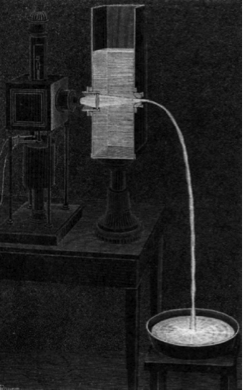Upgrading LHCb with a Large Scintillating Fibre Tracker
When Jean-Daniel Colladon, a 38-year-old Swiss professor at the University of Geneva, demonstrated in 1841 for the first time light guiding due to total internal reflection in a jet of water [1], he may hardly have divined the range and importance of the applications his discovery might have, in everyday life and in science.


Total internal reflection of light in thin glass fibres allows the transport of huge amounts of information at the speed of light, between detector components, houses and even between continents. There is however another application, which is even more important for the new tracking detector, which LHCb is developing for installation during Long Shutdown 2 (LS2). The SciFi Tracker makes use of more than 10’000 km of so-called scintillating plastic fibres. The acronym SciFi stands then for Scintillating Fibres and not for Science Fiction as the less well informed may have guessed.
An integral part of an ambitious overall upgrade of the LHCb detector (see article ‘The LHCb Upgrade’ by Andreas Schopper 16 May 2014), the SciFi tracker is conceived to measure the tracks and angles of all charged particles which have passed LHCb’s huge shark-mouth magnet. With its 6 m width and 5 m height it will be the largest SciFi tracker ever built. To measure both coordinates (x and y) as well as the corresponding angles of the tracks, the SciFi tracker will have 12 planes which are distributed in the space available between the magnet and the so-called RICH2 detector. The SciFi tracker will allow LHCb to profit even better from the high luminosity of the LHC accelerator, but it will also have to stand the increased radiation levels.
But why will this detector be based on scintillating fibres? And what actually is scintillation?
Scintillation describes a very fast fluorescence phenomenon occurring in certain materials when they are exposed to ionising radiation which deposits energy in the material. Scintillators in general can therefore be used as particle detectors. The particular interest in scintillating fibres lies in the fact that they act not only as a particle detector but also transport the information in form of a light pulse through the fibre to the photodetector. One can therefore build very lightweight detectors where all necessary infrastructures like photodetectors, cables and mechanical structures can be moved outside the active detector region. A dream for every detector physicist!
The SciFi technique has a long history in particle physics and some experiments at CERN, like UA2 and CHORUS, were cornerstones in the evolution of this technique. In all SciFi trackers, the fibres need to be arranged in clever patterns such that the passage of the particles tells us the position (in two coordinates) where it passed. The smaller the diameter of the fibre, the better the achievable accuracy of the hit reconstruction. The LHCb SciFi tracker will use fibres of only 0.25 mm diameter giving it an accuracy of better than 0.1 mm (the diameter of a human hair).
In the new LHCb SciFi tracker, about 3 million fibres need to be read at every LHC bunch crossing, i.e. 40 million times a second. Fortunately, 5 or 6 fibres can be grouped to one readout channel, such that ‘only’ 600 000 of very fast and compact photodetectors are needed. It is the dramatic progress in the photodetection technology of the last decade which makes this possible. The so-called silicon Photo-Multiplier (SiPM), the new kid on the block, is almost perfectly suited for this task. Made from silicon like a microelectronics chip, arrays of very small SiPMs can be produced which are sensitive to minute light signals down to single photons.

Blue scintillation light at the end face of a 6-layer fibre mat. The mat is about 1.5 mm thick.
The main challenge to build a SciFi tracker at a hadron collider like the LHC comes from the high radiation levels, both the ionising charged particles which we actually want to measure, but also the cloud of neutrons which are mainly produced in nuclear reactions in the LHCb calorimeters. The radiation gradually degrades the transparency of the fibres such that less and less scintillation light arrives at the SiPM. Joint R&D with fibre producers aims at producing fibres which are initially very transparent and produce a particularly high level of scintillation light. The radiation also affects the operation of the SiPM detectors. Like every silicon device, they become noisy, i.e. they appear to see scintillation light even if there wasn’t any. Reducing their operational temperature to e.g. -40°C is a drastic but very efficient cure for this unusual form of hallucination.

Detail of a 128-channel SiPM array, shown at the same scale as the fibre mat.
The LHCb SciFi team, a group of about 20 institutes around the globe, faces four exciting and challenging years until mid-2018, when this tracker shall be ready for installation in the experiment, down in the underground cavern at point 8. If everything goes well, it will from the year 2020 on accurately measure particle tracks in the upgraded LHCb detector.
Prof. Colladon would certainly be proud of this great application of the phenomenon he discovered 173 years ago.
[1] D. Colladon, “On the reflections of a ray of light inside a parabolic liquid stream,” Comptes Rendus 15, 800 (July-Dec. 1842)
